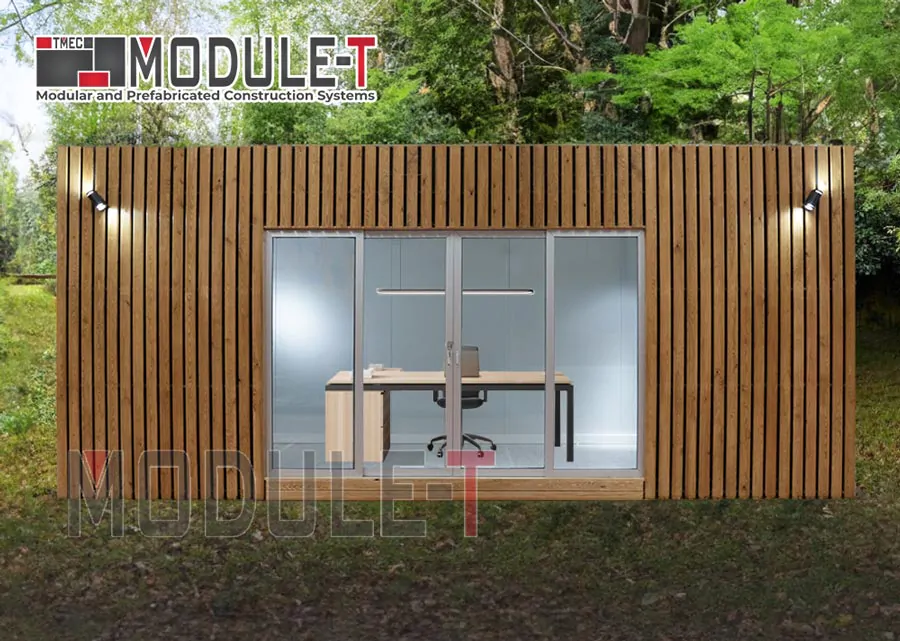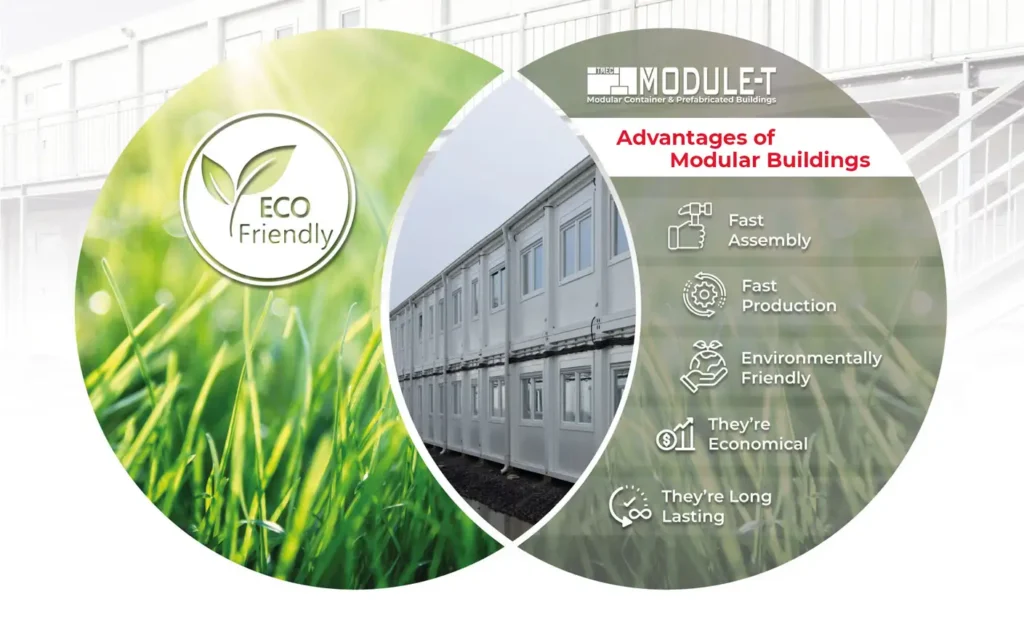Green Living: Sustainability in Prefabricated Container Construction
31 July 2024Sustainability in prefabricated container construction transforms modern buildings by minimizing waste and promoting eco-friendly practices. Repurposing containers reduces the need for raw materials, lowers carbon footprints, and aligns with circular economy principles. Sustainability in prefabricated container construction also integrates renewable energy solutions such as solar panels and rainwater harvesting, contributing to energy-efficient operations.
Industries like construction, mining, and oil and gas are increasingly adopting sustainability in prefabricated container construction to meet environmental goals while optimizing costs. With faster build times, reduced material waste, and enhanced efficiency, prefabricated containers offer a sustainable path toward resilient infrastructure and greener operations.
Why is Prefabrication Sustainable?
Sustainability in prefabricated container construction is vital in reducing environmental impact by minimizing material waste, lowering on-site emissions, and cutting energy use. This construction method ensures sustainable development through resource-efficient production in controlled environments, reducing ecological disruption. As the history of sustainability shows, decreasing dependence on non-renewable resources is essential, and prefabrication achieves this by recycling materials and optimizing design for efficiency.
Companies often showcase prefabrication efforts in their sustainability report to track progress toward sustainable goals. This approach aligns with core sustainability principles, balancing environmental responsibility, operational efficiency, and social impact. Modular solutions, such as dormitory containers, demonstrate how prefabrication combines functionality with eco-conscious practices, providing efficient spaces with minimal environmental impact. Sustainability in prefabricated container construction reflects a forward-thinking sustainability vision, meeting today’s green standards while building resilience for the future.
What are Sustainability Factors in Building?
Sustainability in prefabricated container construction involves optimizing materials, minimizing waste, and adopting renewable technologies. One key factor is environmental sustainability, which emphasizes using eco-friendly materials and integrating systems like prefab buildings. Environmental, social, and governance (ESG) criteria have made these factors essential for companies pursuing responsible practices.
To achieve efficiency, construction companies use environmental sustainability examples, such as modular systems or recycled components. These factors often form part of a sustainability to-do list that guides developers toward greener operations. By following sustainability principles, businesses can achieve environmental, social, and economic balance through resource-efficient designs.
The Importance of Sustainability in Prefabricated Container Construction
The importance of sustainability in prefabricated container construction lies in its potential to reduce environmental impact while delivering economic benefits. The construction sector is a major contributor to global carbon emissions, making sustainable practices essential. Sustainable construction actively combats climate change by using carbon-neutral materials, energy-efficient techniques, and renewable resources.
Innovative designs that enhance durability and optimize natural lighting and ventilation conserve resources and lower operational costs. Techniques like green roofing and permeable materials improve environmental performance by reducing urban heat and effectively managing stormwater. These methods help cities become more sustainable and livable, aligning the industry with broader carbon-neutral goals. As the construction sector adopts these practices in its prefab labor camps, it sets a new standard for responsible urban development and promotes the widespread adoption of eco-friendly techniques.
Eco-Friendly Materials: Choosing Sustainability in Prefabricated Container Construction
Choosing the right materials is critical in amplifying the sustainability of prefabricated container construction. Eco-friendly materials like sustainable wood and non-toxic insulation play a significant role in reducing waste reduction and its impact. These materials help lower the carbon footprint of buildings and contribute to healthier living environments. Incorporating such materials into a container enhances the overall efficiency of the structures.
Carbon-neutral materials support the circular economy, pushing the industry towards more sustainable practices. By selecting appropriate sustainable materials, builders and architects can ensure that their projects are environmentally responsible and aligned with global sustainable development goals. The strategic use of these materials mitigates the negative impacts on the environment and promotes a healthier, more sustainable future for all. Through careful planning and the implementation of standards that encourage eco-friendly materials, the industry can continue to innovate while preserving vital ecological resources and reducing greenhouse gas emissions.
This focus on zero waste is crucial for our planet’s long-term health and its inhabitants’ well-being. By integrating these materials, containers support global sustainability efforts and set a new standard for the industry. The move towards more sustainable material usage is a critical step in reducing the industry’s environmental footprint and promoting a more sustainable future for all.
Strategies for Reducing Environmental Impact in Container Buildings
Implementing effective strategies to reduce the environmental impact of container buildings is critical to achieving sustainable development. A core element of sustainability in prefabricated container construction is optimizing designs for energy efficiency by incorporating technologies such as solar panels, energy-efficient windows, and insulation systems. Passive solar design, which leverages sunlight for natural heating, further enhances thermal efficiency and lowers long-term energy consumption. Additional strategies, like green roofs and water-saving systems, mitigate ecological footprints by reducing resource waste and promoting biodiversity.
Prefabricated solutions like the office container are ideal examples of modular design that not only reduce construction waste but also improve operational efficiency. Modular parts ensure faster build times and reduce transportation emissions, aligning with carbon-neutral goals. These strategies reflect the construction sector’s shift toward sustainable practices by focusing on resource management, energy conservation, and reduced environmental impact.
By implementing these sustainable techniques, container buildings contribute to ecological and economic objectives. Their reduced reliance on non-renewable resources, coupled with lower operational costs, makes them a smart financial investment. These environmentally friendly strategies also improve urban sustainability, setting new industry standards for sustainable infrastructure. Prefabricated containers thus provide durable, efficient spaces while leading the way in creating environmentally responsible and future-ready buildings.
Sustainability in Prefabricated Container Construction: Case Studies
Examining successful case studies of sustainability in prefabricated container construction provides valuable insights into practical applications of green building practices. Projects like Container City in London demonstrate how containers can be aesthetically pleasing and environmentally sustainable. These developments utilize durable, renewable materials, incorporate renewable energy solutions, and showcase innovative approaches to sustainable architecture. Container City exemplifies the use of containers in creating dynamic urban spaces that serve functional purposes while modeling sustainable development. It incorporates solar panels, green roofs, and efficient insulation systems, demonstrating how containers transform into energy-efficient, renewable energy-supported living spaces.
Other notable examples include the Containhotel in the Czech Republic, which utilizes rainwater harvesting and solar power, and the Ccasa Hostel in Vietnam, which showcases creative design solutions for natural ventilation and lighting. These projects highlight containers’ versatility in different climates and contexts. By studying these green building practices, builders and developers can learn effective strategies for implementing sustainable design principles, promoting broader adoption of eco-friendly techniques. These case studies demonstrate the viability and benefits of incorporating durability into projects, providing blueprints for future developments.
Beyond environmental benefits, these projects offer social advantages by creating unique, community-focused environments that foster interaction and community building. Many incorporate shared spaces, rooftop gardens, and communal areas to encourage resident engagement. These developments often revitalize underutilized urban areas, contributing to urban regeneration and efficient land use. They address housing shortages while minimizing impact, enhancing occupants’ quality of life, and serving as models of sustainable urban living. As more successful case studies emerge, they continue to inspire and inform the future of sustainable container architecture worldwide.
The Future of Sustainability in Prefabricated Container Construction
As modular containers evolve, sustainability in prefabricated container construction drives innovations that promote zero waste, energy efficiency, and enhanced livability. Future strategies focus on biodegradable materials, renewable energy systems, and smart waste management to protect the environment and create healthier living spaces for future generations. These innovations align with the goal of carbon-zero construction, ensuring long-term sustainability.
Technologies like transparent solar panels, seamlessly integrated into windows and walls, generate clean energy while maintaining natural light and aesthetic appeal. Smart energy management systems optimize power consumption, making container buildings more efficient. Modular units, such as sanitary containers, also enhance urban living by providing essential infrastructure with minimal environmental impact.
Urban areas face housing and environmental challenges, and modular containers offer a sustainable solution that addresses both. With ongoing advancements, the container industry is poised to lead in green practices and sustainable urbanization. To explore how Module-T’s modular solutions can support your sustainability goals, visit our portfolio and discover the future of eco-friendly construction.
CONTACT US
MODULE-T
KURIS KULE D-100 GUNEY YANYOL NO: 2 / 77-78 , KARTAL/ISTANBUL - TURKEY
PREFABRIK DIS TIC VE SAN LTD STI- +90 216 441 01 77
- Send Whatsapp Message
- info@module-t.com


